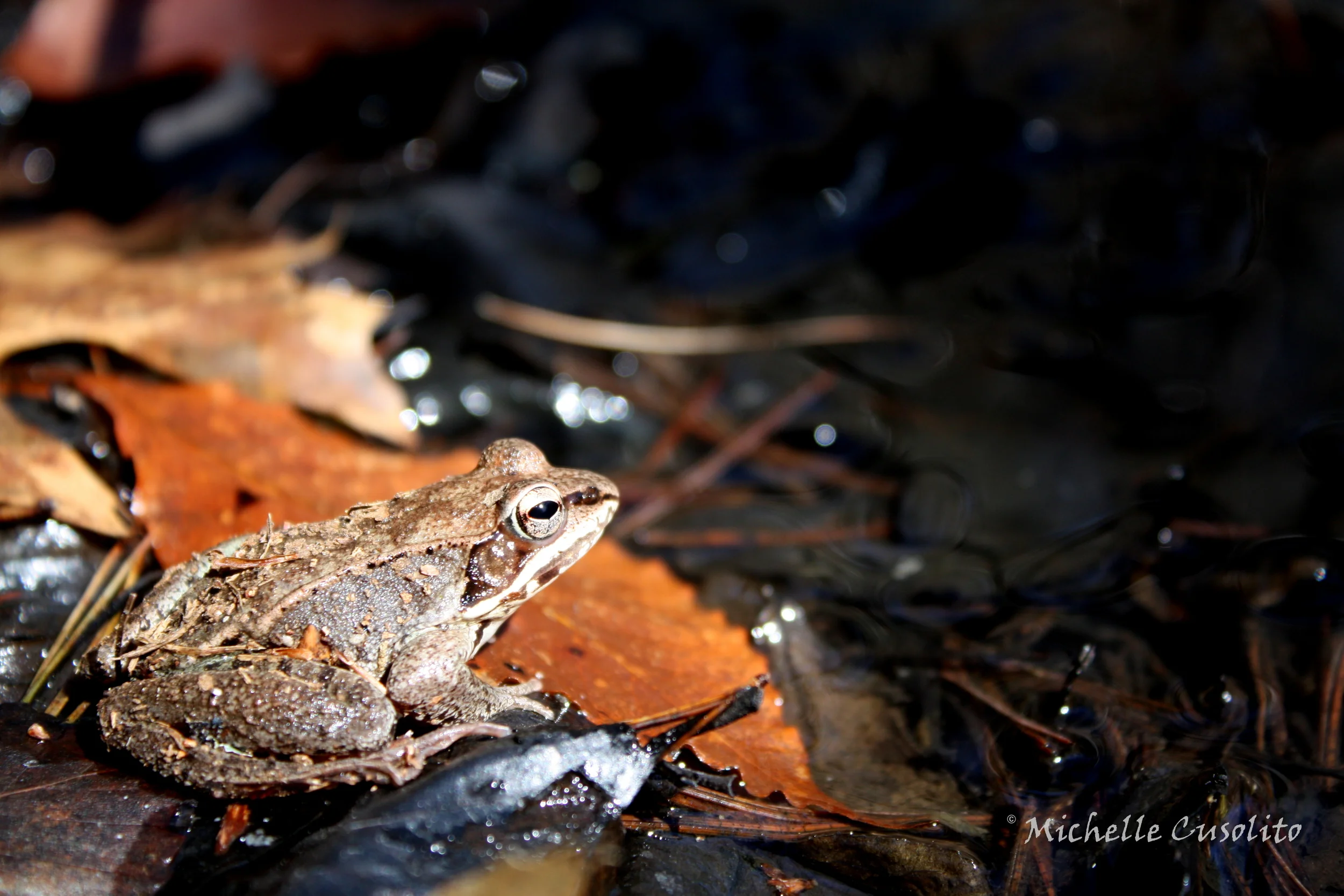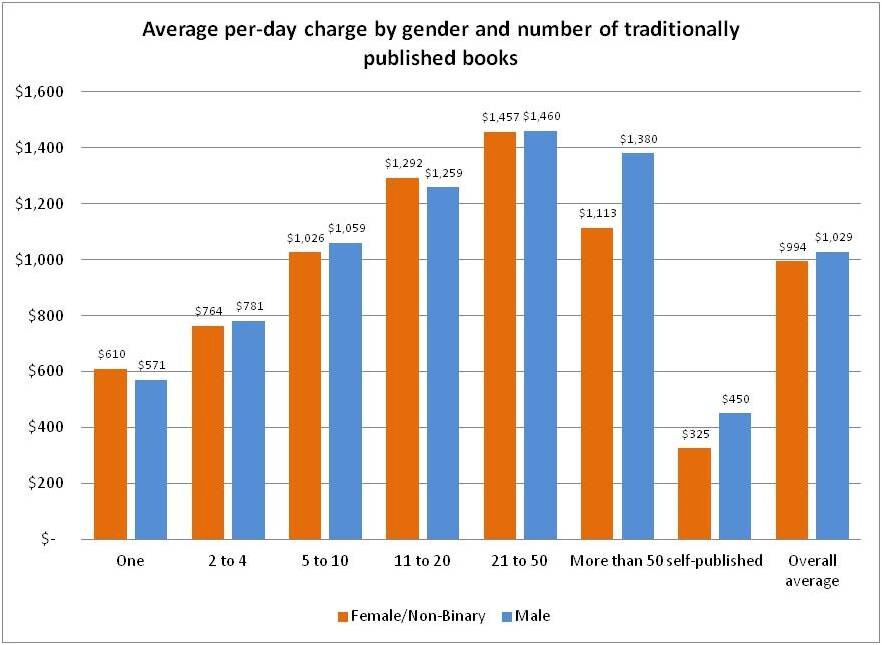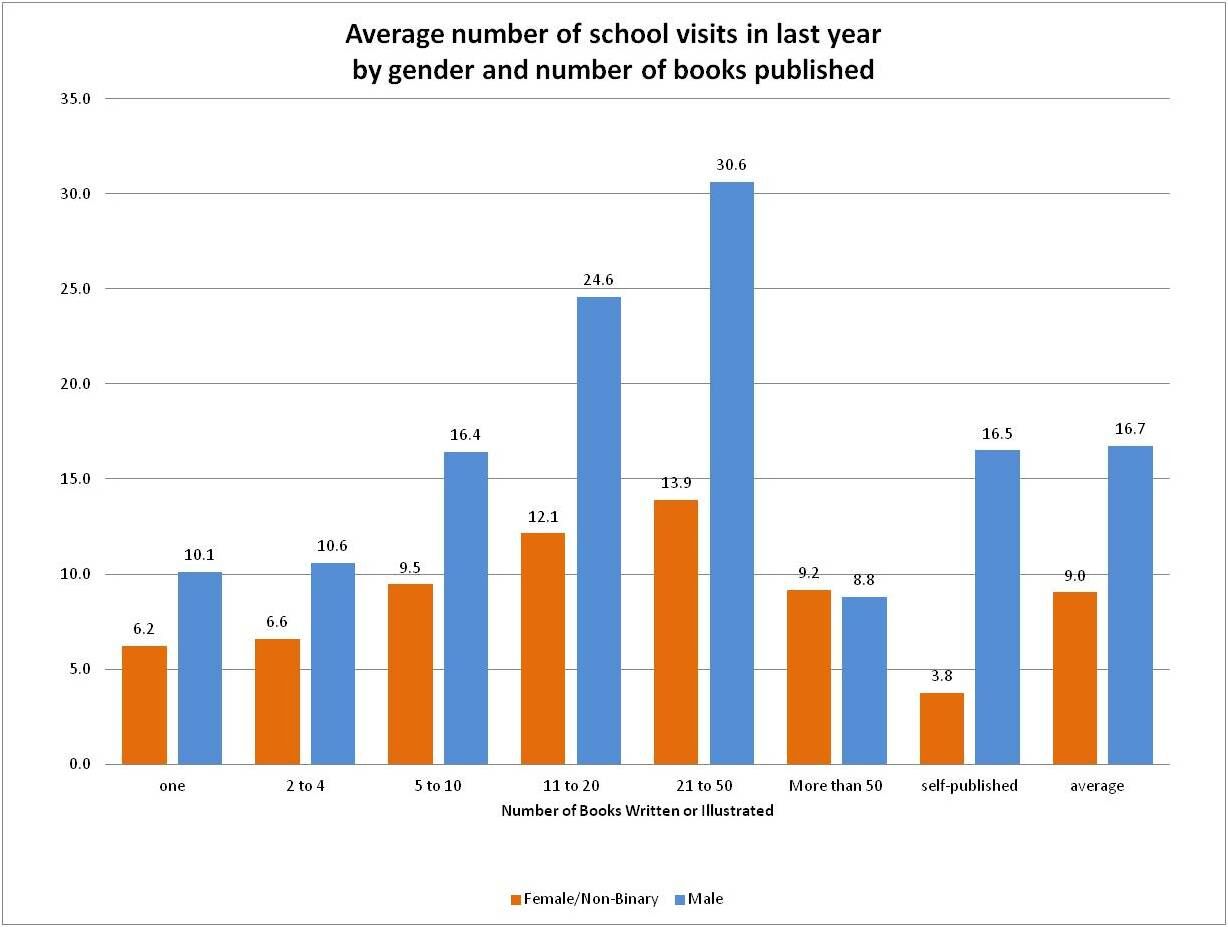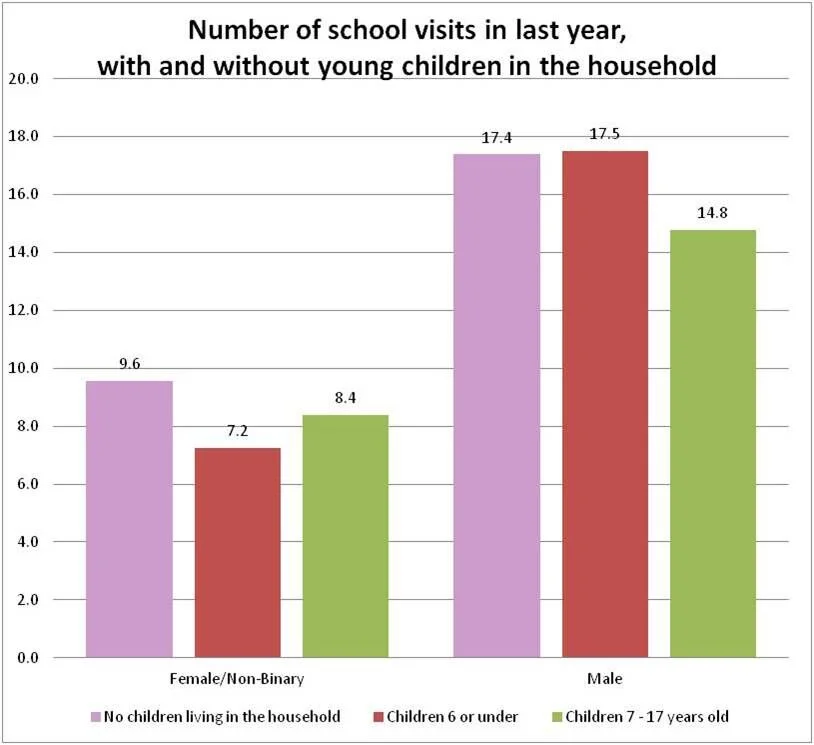Note
Please see our first post for information about how we categorized gender and race/ethnicity.
Is there an earnings gap?
As we mentioned in our last post, 8 percent of our survey respondents did all of their school visits for free. The following chart excludes this 8 percent. It shows the average charge for only those respondents who charged.
Male respondents and female/non-binary respondents had close to equal per-day rates. This was true at almost all levels of number of books published.
Female/non-binary and male respondents are charging similar rates at most career levels.
At two points male respondents are charging more than female/non-binary respondents: people who have published more than 50 books (5 percent of respondents), and self-published authors (3 percent of respondents).
Price vs. Quantity
While there is not a large gap between male and female/non-binary respondents in terms of rate, there is a significant difference in the total number of school visits done in the last year. (Note that the following graph includes all respondents – including those who do all visits for free).
We found that, overall:
Female/non-binary respondents did an overall average of 9 school visits in the last year.
Male respondents did almost twice as many - an overall average of 17 school visits.
There appears to be a gap at all career stages, except for those creators who have published more than 50 books.
Debut male creators (those who have published only one book so far) did more school visits than female/non-binary creators who have published 5-10 books.
Self-published men did more school visits than female/non-binary respondents who have traditionally published 21-50 books. (The range of number of self-published books was 1-9)
A couple of comments we received:
“ Interesting to note that a few school librarians told me that they actively seek male authors because so many of their students do not have father figures.”
“I have noticed that when I do library conferences, the librarians will talk to/take info from male authors next to me, and not even make eye contact with me. One of my books (while not winning any national awards) has won 3 different state awards, and has been nominated for many more.”
Age
Anecdotally, authors have shared stories about feeling that age discrimination may come into play in school visits. We asked about age in our survey because of these stories from women in particular, who felt that being an older (or younger) woman was a disadvantage when trying to book school visits.
Only one of our respondents commented about this experience of feeling that her age was a factor in her ability to price herself fairly. She commented:
“... a younger woman, I find that a lot of schools expect that I shouldn't charge. It's a quandary, because there are of course certain school districts (particularly majority Chinese American ones) which as an Asian-American author I want to visit, and am willing to regardless of need. However, it puts me in a tough position - when I offer to do a visit in a school for free, suddenly word spreads and wealthier districts want the same, and are somewhat affronted when I ask for money.”
We found that at most age levels, male respondents are doing more - many more - school visits than female or non-binary respondents.
For respondents over 65, men are doing fewer school visits than female/non-binary respondents. (6 percent of respondents were over 65)
Given the questions we asked - and didn’t ask - in this survey, we can’t state definitively if age discrimination is a problem in school visits or not.
Caregiving and its effect on school visits
One reason often given for women doing fewer school visits than men is that women are still more likely to be primary caregivers of the very young and very old. Several respondents commented that they had reduced or eliminated their school visits for a period of time due to maternity leave or caring for an elderly relative.
(We only included respondents who had done at least one school visit in the last year in these survey results, but we plan to write a separate blog post about people who had not done any, because they had interesting things to say.)
We found:
Female/non-binary respondents with children 6 or under in their households did an average of 2.4 fewer school visits than female/non-binary respondents with no children at home (25% fewer visits).
Male respondents with children 6 or under in their households had the same average number of visits as men without children in their household.
Men with children age 7-17 in the household had a 15% lower average numbers of school visits than did those without children. Female/non-binary respondents had 12.5% lower.
With children in the household or without, male respondents did significantly more school visits than female/non-binary respondents.
Some respondents wrote in comments about their caregiving responsibilities and their choice to limit travel:
“I had a baby last year and turned down all school visit invitations to limit travel.”
“I usually do a few visits a year, but my parents' health precluded that in 2017.”
Summary
We found that female/non-binary children’s literature creators are earning similar rates for school visits as male creators. However, there is a large gender gap in the number of visits per year of each group. This gap is not fully explained by either caregiving burden or age discrimination.
While we cannot answer the “why” behind that gap with this survey, we hope that the knowledge that it exists, and the pricing information that respondents shared, will create a more transparent school visit booking and pricing experience for all children’s literature creators.
Next full post: We will look at free and reduced-price school visits, and their gender dynamics
About the authors of this study
We (Jeanette Bradley and Michelle Cusolito) volunteered our time and expertise to bring you the results of this survey. We’d appreciate any support you might offer us in return. Perhaps you could buy our books (or rather, pre-order Michelle’s), request them from the library, tweet about them, or write a review if you’ve read them and enjoyed them. Thank you for considering.
Jeanette Bradley has been an urban planner, an apprentice pastry chef, and the artist-in-residence for a traveling art museum on a train. (Yes, she is a data nerd who can draw.) Her debut picture book LOVE, MAMA was published by Macmillan/Roaring Brook Press. It contains no cities, pastries, or trains, but was made with lots of love. She currently lives in Rhode Island with her wife and kids. Jeanette is represented by Emily Mitchell of Wernick & Pratt.
You’ve landed on Michelle’s blog/website, so you can poke around to learn more about her. In case you missed it, here’s the cover of Flying Deep, which comes out May 22nd.







